1930 German federal election
Federal elections were held in Germany on 14 September 1930.[1] Despite losing ten seats, the Social Democratic Party of Germany (SPD) remained the largest party in the Reichstag, winning 143 of the 577 seats, while the Nazi Party (NSDAP) dramatically increased its number of seats from 12 to 107.[2] The Communists also increased their parliamentary representation, gaining 23 seats and becoming the third-largest party in the Reichstag.
| |||||||||||||||||||||||||||||||||||||||||||||||||||||||||||||||||||||||||||||||||||||
All 577 seats in the Reichstag 289 seats needed for a majority | |||||||||||||||||||||||||||||||||||||||||||||||||||||||||||||||||||||||||||||||||||||
|---|---|---|---|---|---|---|---|---|---|---|---|---|---|---|---|---|---|---|---|---|---|---|---|---|---|---|---|---|---|---|---|---|---|---|---|---|---|---|---|---|---|---|---|---|---|---|---|---|---|---|---|---|---|---|---|---|---|---|---|---|---|---|---|---|---|---|---|---|---|---|---|---|---|---|---|---|---|---|---|---|---|---|---|---|---|
| Registered | 42,982,912 | ||||||||||||||||||||||||||||||||||||||||||||||||||||||||||||||||||||||||||||||||||||
| Turnout | 35,224,499 (82.0%) | ||||||||||||||||||||||||||||||||||||||||||||||||||||||||||||||||||||||||||||||||||||
| |||||||||||||||||||||||||||||||||||||||||||||||||||||||||||||||||||||||||||||||||||||
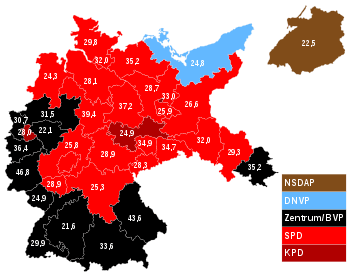 Constituencies coloured according to the party that received the largest share of the vote. | |||||||||||||||||||||||||||||||||||||||||||||||||||||||||||||||||||||||||||||||||||||
| |||||||||||||||||||||||||||||||||||||||||||||||||||||||||||||||||||||||||||||||||||||
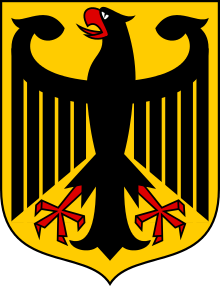 |
|---|
| This article is part of a series on the politics and government of Germany |
|
|
Head of State |
|
Executive
|
|
|
Administrative divisions
|
|
Background
The Social Democratic Party of Germany (SPD) had won the most votes and was the largest party in most elections from 1919 to 1932. They led the coalition government between 1919-1920 and 1928-1930.
After the 1928 German federal election, a grand coalition was formed under the Social Democratic chancellor Hermann Müller. The coalition collapsed on 27 March 1930. President Hindenburg appointed Centre Party politician and academic Heinrich Brüning as chancellor, who formed a minority government.
The new government was confronted with the economic crisis caused by the Great Depression. Brüning disclosed to his associates in the German Labour Federation that his chief aim as chancellor would be to liberate the German economy from the burden of continuing to pay war reparations and foreign debt. This would require an unpopular policy of tight credit and a rollback of all wage and salary increases (an internal devaluation). The Reichstag rejected Brüning's measures within a month, who then used emergency powers to pass it anyway. The Reichstag rejected the emergency decree with 256 votes from the Social Democrats, the Communists, the German National People's Party and the Nazis. Brüning asked Hindenburg to dissolve the Reichstag, who promptly did so on 18 July 1930. New elections were held on 14 September 1930.
Electoral system
In 1930, Germany was formally a multi-party parliamentary democracy, led by President Paul von Hindenburg (1925–1934). However, beginning in March 1930, Hindenburg only appointed governments without a parliamentary majority which systematically governed by emergency decrees, circumventing the democratically elected Reichstag.
The electoral law awarded one seat in the Reichstag per 60,000 votes. All citizens over 21 could vote through a system of proportional representation, a new parliament was elected every four years to deal with issues related to taxes, trade, defense, etc. The President was directly elected every seven years and was primarily in control of the armed forces, however, he also had significant powers to dissolve the Reichstag, nominate a Chancellor, veto laws, and utilize article 48.
Campaign
In 1930, there were 37 individual parties running for office, only ten of which secured over 3% of the popular vote. The top five political parties participating in the 1930 election were the following:
| Political party | Ideology | Political position | Leader | |
|---|---|---|---|---|
| Social Democratic Party of Germany | Social democracy | Centre-left | Otto Wels & Arthur Crispien | |
| National Socialist German Workers Party | National Socialism | Far-right | Adolf Hitler | |
| Communist Party of Germany | Communism, Marxism | Far-left | Ernst Thälmann | |
| Centre Party | Political Catholicism | Centre-right | Ludwig Kaas | |
| German National People's Party | Conservatism, Monarchism | Right-wing | Alfred Hugenberg | |
The Nazis had increased their share of the vote in state elections since their 1928 federal election result. The SPD designated the "bourgeois block" and the Nazis as their enemies and, with the KPD, held rallies in Berlin on 1 August 1930 under the motto "Never again war". Some 30,000 participated in the SPD rally in the Lustgarten and 15,000 in the KPD demonstration at the Winterfeldtplatz. On 23 August, KPD members attacked a Nazi event in Bunzlau. Three people were killed and two seriously injured in fighting with the police. The KPD election campaign climaxed with a rally in the Berlin Sportpalast on 12 September.
Results
The 1930 German election drew a record 82% voter turnout. The Social Democratic Party of Germany (SPD) remained the strongest party and won 143 seats, a loss of 10 seats from the previous election. The National Socialist German Workers Party (NSDAP) rose to become the second-largest party with 18.25% of the vote and gained 107 seats, a massive increase from the 12 seats that had been gained in the last election. The only other party to increase its seats was the Communist Party of Germany, which won 13.13% of the vote, securing 77 seats, 23 more than in the last election. The 34 other political parties shared the remainder of the votes.
 | ||||
|---|---|---|---|---|
| Party | Votes | % | Seats | +/– |
| Social Democratic Party | 8,575,244 | 24.53 | 143 | –10 |
| National Socialist German Workers' Party | 6,379,672 | 18.25 | 107 | +95 |
| Communist Party of Germany | 4,590,160 | 13.13 | 77 | +23 |
| Centre Party | 4,127,000 | 11.81 | 68 | +7 |
| German National People's Party | 2,457,686 | 7.03 | 41 | –32 |
| German People's Party | 1,577,365 | 4.51 | 30 | –15 |
| German State Party | 1,322,034 | 3.78 | 20 | –5 |
| Reich Party of the German Middle Class | 1,361,762 | 3.90 | 23 | 0 |
| Christian-National Peasants' and Farmers' Party | 1,108,043 | 3.17 | 19 | +10 |
| Bavarian People's Party | 1,058,637 | 3.03 | 19 | +2 |
| Christian Social People's Service | 868,269 | 2.48 | 14 | New |
| German Farmers' Party | 339,434 | 0.97 | 6 | –2 |
| Conservative People's Party | 290,579 | 0.83 | 4 | New |
| Reich Party for Civil Rights and Deflation/Christian Social Reich Party | 271,291 | 0.78 | 0 | –2 |
| Agricultural League | 193,926 | 0.55 | 3 | 0 |
| German-Hanoverian Party | 144,286 | 0.41 | 3 | –1 |
| Christian Social Peoples Community | 81,550 | 0.23 | 0 | New |
| Polish People's Party | 72,913 | 0.21 | 0 | 0 |
| Schmalix Greater German List | 26,707 | 0.08 | 0 | New |
| House and Property Owners | 25,530 | 0.07 | 0 | 0 |
| Conservative People's Party/German-Hanoverian Party | 22,218 | 0.06 | 0 | – |
| Independent Social Democratic Party of Germany | 11,690 | 0.03 | 0 | 0 |
| Freibund des Handwerks, Kleinhandels und Gewerbes | 9,531 | 0.03 | 0 | New |
| Radical German State Party | 8,841 | 0.03 | 0 | New |
| Deutsche Einheitspartei für wahre Volkswirtschaft | 6,915 | 0.02 | 0 | New |
| Kriegsbeschädigten- und Hinterbliebenenpartei der deutschen Mannschaft einschließlich der Abgefundenen | 6,704 | 0.02 | 0 | New |
| Deutsche Kulturpartei der geistigen Berufe, Angestellten und Beamten | 6,181 | 0.02 | 0 | New |
| Handel, Handwerk, Hausbesitz | 3,644 | 0.01 | 0 | New |
| Schleswig Club | 1,785 | 0.01 | 0 | 0 |
| Menschheitspartei und neue Volksgemeinschaft | 1,626 | 0.0 | 0 | New |
| Evangelical voters | 1,326 | 0.0 | 0 | New |
| Party against Alcohol | 1,171 | 0.0 | 0 | New |
| Workers Party for Creative Workers | 907 | 0.0 | 0 | New |
| Prussian-Lithunanian People's Party | 666 | 0.0 | 0 | New |
| Renter and People's Reich Party | 653 | 0.0 | 0 | New |
| People's Party of the Lusatian Sorbs | 288 | 0.0 | 0 | New |
| Friesland | 237 | 0.0 | 0 | 0 |
| Invalid/blank votes | 268,028 | – | – | – |
| Total | 35,224,499 | 100.00 | 577 | +86 |
| Registered voters/turnout | 42,982,912 | 82.0 | – | – |
| Source: Gonschior.de | ||||
References
- Dieter Nohlen & Philip Stöver (2010) Elections in Europe: A data handbook, p762 ISBN 978-3-8329-5609-7
- Nohlen & Stöver, p790

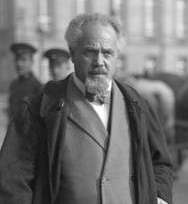
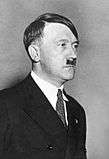
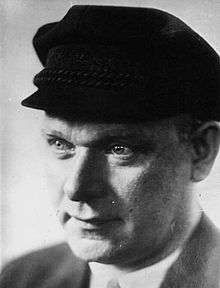
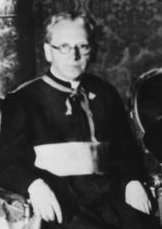
.jpeg)
.jpg)